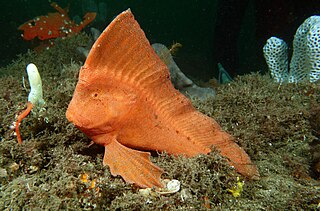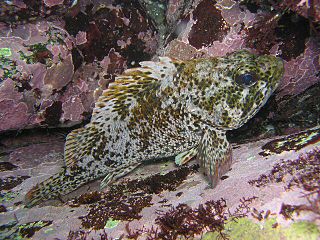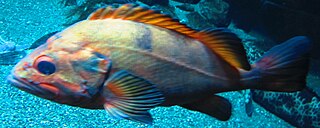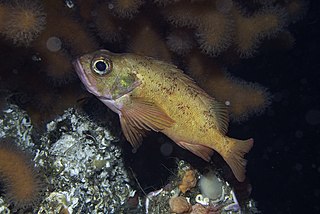
The red velvetfish is a species of marine ray-finned fish, it is the only species in the monotypic genus Gnathanacanthus and monogeneric family Gnathanacanthidae. This species is endemic to the inshore waters of western and southern Australia.

Congiopodidae, commonly known as pigfishes, horsefishes and racehorses, is a family of ray-finned fish classified with in the order Perciformes. These fishes are native to the Southern Hemisphere.

Setarchinae, the deep-sea bristly scorpionfishes, is a small subfamily of deep-sea ray-finned fishes, it is part of the family Scorpaenidae. They are small marine fishes, growing up to 25 cm, and are found in tropical and subtropical waters throughout the world.

Peristediidae, the armored sea robins or armoured gurnards, is a family of ray-finned fishes belonging to the suborder Platycephaloidei in the order Scorpaeniformes. They are found in the deep water in the tropical and warm temperate of the world's oceans.

The Australian prowfishes are a small family, the Pataecidae, of ray-finned fishes classified within the order Scorpaeniformes. Australian prowfishes are distinguished by a long dorsal fin that begins far forward on the head, forming a "prow" shape, and extends all the way to the caudal fin. They lack scales and pelvic fins.

Little velvetfishes or simply velvetfishes are a family, the Aploactinidae, of marine ray-finned fishes classified within the order Scorpaeniformes. They are small fish that have skin with a velvet texture. They live on the sea bottom close to the shore, at depths of up to 100 metres (330 ft). They are found in the Indo-Pacific region.

Helicolenus is a genus of marine ray-finned fishes belonging to the family Scorpaenidae where they are classified within the subfamily Sebastinae, the rockfishes. The species in this genus are found in the Indian, Atlantic and Pacific oceans.

Helicolenus percoides, the reef ocean perch, coral cod, coral perch, Jock Stewart, kuriarki, ocean perch, red gurnard perch, red gurnard scorpionfish, red ocean perch, red perch, red rock perch, scarpee or sea perch, is a species of marine ray-finned fish belonging to the subfamily Sebastinae, part of the family Scorpaenidae. It is found in the southwestern Pacific Ocean.

Sebastolobus, the thornyheads, is a genus of marine ray-finned fish belonging to the subfamily Sebastinae, the rockfishes, part of the family Scorpaenidae. These fishes are native to the northern and eastern Pacific Ocean. They are generally found in deep waters.

Pterygotrigla is a genus of genus of marine ray-finned fishes belonging to the family Triglidae, the gurnards and sea robins, one of two genera belonging to the subfamily Pterygotriglinae. These gurnards are found in the Indian and Pacific oceans.
The deceitful velvetfish is a species of marine ray-finned fish, a velvetfish, belonging to the family Aploactinidae. This species is endemic to the oceans around Australia. This species is the only known member of its genus.

Platycephaloidei is a suborder of ray-finned fishes, part of the order Scorpaeniformes, and includes the flatheads, ghost flatheads and sea robins.

Easchmeyer nexus is a species of marine ray-finned fish; it is the only species in the monotypic genus Eschmeyer and monogeneric family Eschmeyeridae. This fish is only known from the Pacific Ocean, near Fiji.

Maxillicosta is a genus of marine ray-finned fishes, belonging to the subfamily Neosebastinae, the gurnard scorpionfishes, part of the family Scorpaenidae. They are native to the eastern Indian Ocean and the western Pacific Ocean.

Neosebastes is a genus of marine ray-finned fishes, belonging to the subfamily Neosebastinae, the gurnard scorpionfishes, part of the family Scorpaenidae. These fishes are found in the Indian and Pacific Ocean.

Sebastes joyneri, the Togot seaperch, offshore seaperch or joyner stingfish, is a species of marine ray-finned fish belonging to the subfamily Sebastinae, the rockfishes, part of the family Scorpaenidae. It is found in the northwestern Pacific Ocean.

Sebastes pachycephalus is a species of marine ray-finned fish belonging to the subfamily Sebastinae, the rockfishes, part of the family Scorpaenidae. It is found in shallow rocky reefs of Northwest Pacific.

Sebastes ventricosus, the Japanese black seaperch or Japanese blueback seaperch, is a species of marine ray-finned fish belonging to the subfamily Sebastinae, the rockfishes, part of the family Scorpaenidae. It is found in the northwestern Pacific Ocean. In Japan this species is known as Mebaru(メバル/鮴).

Sebastes melanostictus, the blackspotted rockfish, is a species of marine ray-finned fish belonging to the subfamily Sebastinae, the rockfishes, part of the family Scorpaenidae. It is found in the northern Pacific Ocean.

Sebastes viviparus, the Norway redfish, small redfish, lesser redfish, ocean perch or rosefish, is a species of marine ray-finned fish belonging to the subfamily Sebastinae, the rockfishes, part of the family Scorpaenidae. It is found in the northern Atlantic Ocean.



















